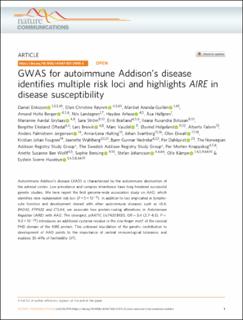GWAS for autoimmune Addison's disease identifies multiple risk loci and highlights AIRE in disease susceptibility
Eriksson, Daniel; Røyrvik, Ellen Christine; Aranda-Guillen, Maribel; Berger, Amund Holte; Landegren, Nils; Artaza, Haydee; Hallgren, Åsa; Grytaas, Marianne; Strøm, Sara; Bratland, Eirik; Botusan, Ileana; Oftedal, Bergithe Eikeland; Breivik, Lars Ertesvåg; Vaudel, Marc; Helgeland, Øyvind; Falorni, Alberto; Jørgensen, Anders Palmstrøm; Hulting, Anna-Lena; Svartberg, Johan; Ekwall, Olov; Fougner, Kristian J; Wahlberg, Jeanette; Nedrebø, Bjørn Gunnar; Dahlqvist, Per; Study group, Norwegian Addison Registry; Study Group, Swedish Addison Registry; Knappskog, Per Morten; Wolff, Anette Susanne Bøe; Bensing, Sophie; Johansson, Stefan; Kämpe, Olof; Husebye, Eystein Sverre
Journal article, Peer reviewed
Published version

View/
Date
2021Metadata
Show full item recordCollections
- Department of Clinical Science [2295]
- Registrations from Cristin [9531]
Abstract
Autoimmune Addison’s disease (AAD) is characterized by the autoimmune destruction of the adrenal cortex. Low prevalence and complex inheritance have long hindered successful genetic studies. We here report the first genome-wide association study on AAD, which identifies nine independent risk loci (P < 5 × 10−8). In addition to loci implicated in lymphocyte function and development shared with other autoimmune diseases such as HLA, BACH2, PTPN22 and CTLA4, we associate two protein-coding alterations in Autoimmune Regulator (AIRE) with AAD. The strongest, p.R471C (rs74203920, OR = 3.4 (2.7–4.3), P = 9.0 × 10−25) introduces an additional cysteine residue in the zinc-finger motif of the second PHD domain of the AIRE protein. This unbiased elucidation of the genetic contribution to development of AAD points to the importance of central immunological tolerance, and explains 35–41% of heritability (h2).
